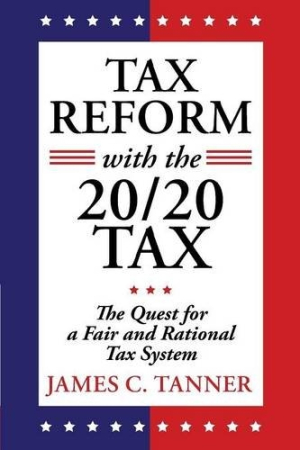Tax Reform with the 20/20 Tax
The Quest for a Fair and Rational Tax System
This painstakingly comprehensive new tax proposal warrants serious attention from policymakers and tax professionals.
In his voluminous and impressive Tax Reform with the 20/20 Tax, tax accountant James C. Tanner takes on the Herculean task of proposing “a new framework and simplified rules” for the U.S. tax code.
Few people, be they ordinary citizens, accountants, or policymakers, would disagree with the basic premise that the US tax system, particularly as it applies to individual income tax, is flawed. Many would go so far as to say the tax code is unfair, and despite political posturing over decades, neither the legislative nor the executive branch has made much progress in fixing it.
James Tanner, a CPA with forty-plus years of experience and special expertise in tax accounting, thinks he has the solution. He calls it the “20/20 Tax.” Under this plan, “most taxpayers would pay a marginal income tax rate of no more than 20% on their highest dollars earned, while almost all deductions and tax credits would benefit taxpayers at a consistent rate of 20%.” He does suggest that the income tax rate for the wealthy should be higher (30%) and for low income earners, it should be lower (a maximum of 10%).
With impressive thoroughness and clarity, Tanner proceeds to lay out his plan in great detail. He begins with a history of federal taxes, as well as a judicious evaluation of alternatives that have been proposed, including the value-added tax, the flat tax, the fair tax, and graduated income tax proposals. Then the book builds its own case, authoritatively reviewing every element of an individual tax return, including income exclusions, capital gains, exemptions, the alternative minimum tax, tax credits, and tax deductions. Each element is discussed in detail, with related explanations of the projected effects of the 20/20 Tax. When appropriate, tables are included that compare current tax rates vs. tax rates under the 20/20 Tax. A revised, illustrative Form 1040 is included, taking the 20/20 Tax into account, and the appendix offers a line-by-line summary analysis of his 20/20 Tax proposal vs. the House Committee on Ways and Means’s Tax Reform Act of 2014.
Tanner is the first to admit that such careful detail can be mind-numbing: “You will undoubtedly hit some dry spots while reading.” Still, this 444-page book seems modestly sized when compared to the 73,000 pages of the current U.S. tax code. Included explanations of proposed changes are remarkably lucid.
It may be asking too much of the general public to embrace and fully comprehend Tax Reform with the 20/20 Tax, but tax professionals and policymakers would do well to read the book. The careful thought behind this comprehensive, non-partisan approach, supported by logic and documentation, seems to make the 20/20 Tax worthy of serious consideration.
Reviewed by
Barry Silverstein
Disclosure: This article is not an endorsement, but a review. The publisher of this book provided free copies of the book and paid a small fee to have their book reviewed by a professional reviewer. Foreword Reviews and Clarion Reviews make no guarantee that the publisher will receive a positive review. Foreword Magazine, Inc. is disclosing this in accordance with the Federal Trade Commission’s 16 CFR, Part 255.

